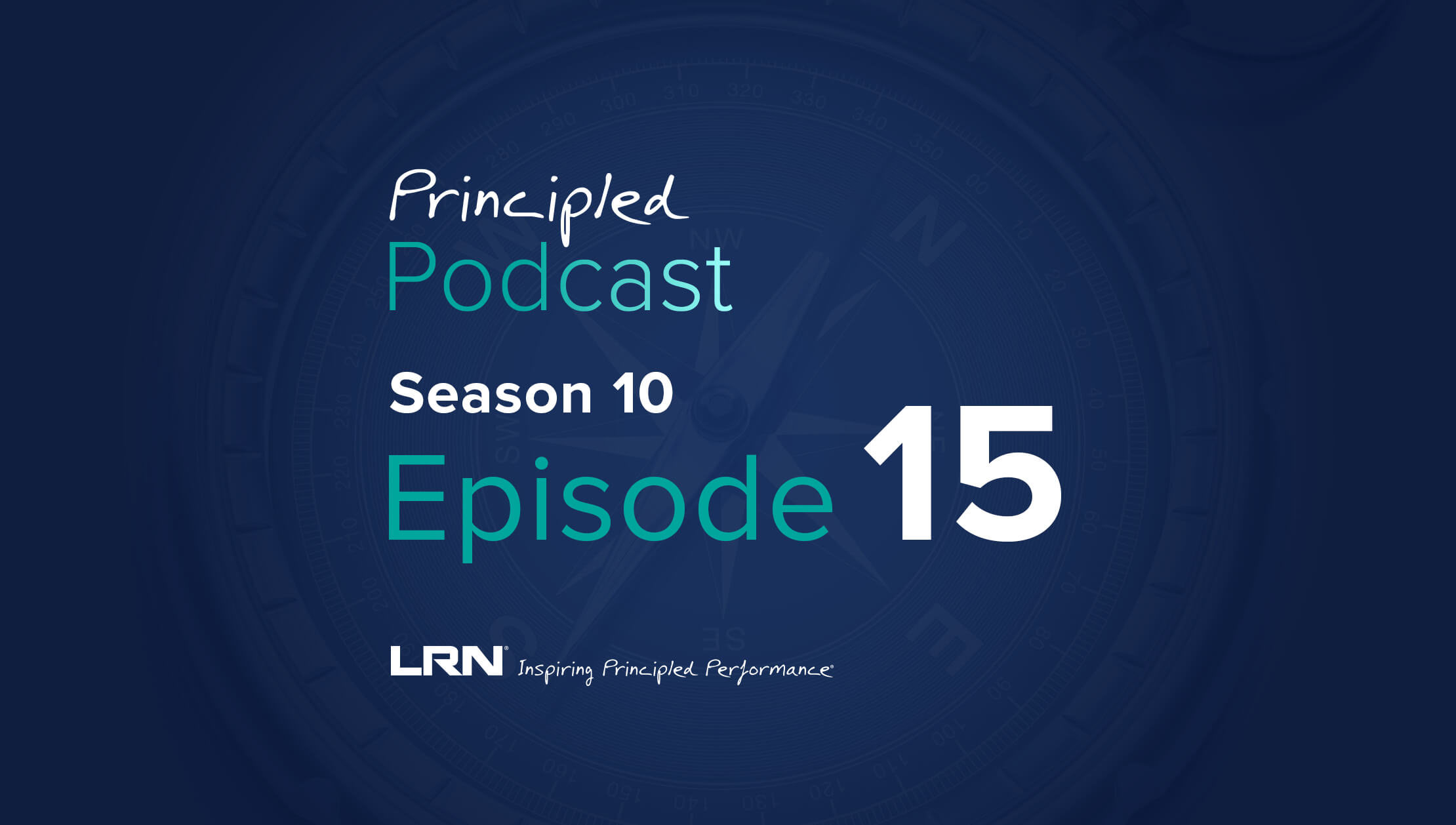The ability for organizations in the mining industry to truly assess culture is critical for keeping pace with rising stakeholder expectations, managing supply chain challenges, and meeting updated regulatory guidance. In fact, data from the LRN Benchmark of Ethical Culture reveals that mining organizations have clear areas of strength and also opportunities to improve their cultures. But what does it actually look like to inspire ethical behavior in a high profile, constantly changing industry? LRN Director Emily Miner sat down with Scott Sullivan, Chief Integrity & Compliance Officer at Newmont Corporation, to explore how this mining company is building a culture of radical transparency.
This interview has been edited for clarity.
Emily Miner: Tell me about Newmont’s evolving transition to a culture of transparency. Where did it start, and where has it gone from there?
Scott Sullivan: In the world of ethics and compliance, most companies get the “compliance” side well before they understand and address the “ethics” piece. That doesn't mean they're unethical or lack integrity. Rather, compliance can be very mechanical in nature, whereas ethics (or integrity) can be more esoteric. That’s where culture comes into play, and most companies struggle with that. What is it? How do you measure it? How do you define success? All those questions and challenges remain to this day. But when I was interviewing at Newmont in 2019, everyone—all the way up from senior leadership to the board of directors—was remarkably consistent in talking about the company’s journey to becoming more transparent and always putting integrity ahead of business results and performance. They understood the compliance and integrity function; in fact, integrity is one of Newmont’s five core values.
In the mining industry, safety is everything. Very early on in my role, our head of safety commented that the organization did “safety shares” at the start of every meeting. She then said, “We really need to shift this to focus on all of our values.” That support gave our team the additional space to focus more on integrity as a value, what it means, and how we put it into play in the organization.
Early in my tenure in 2020, we had a case with a fairly senior individual in the organization that involved a clear, self-dealing conflict of interest. This person was well known and respected by the leadership team and throughout the organization. And, it was the first time that I was delivering the proverbial “bad news” to the organization. Our executive leadership team who attended the briefing for the case didn't skip a beat. They asked good questions. They agreed the situation was clearly wrong and that they would terminate this individual for cause. They wanted to publicize the information with a press release, as this person’s recent move to a new role in the organization had also been externally publicized. And they agreed we should develop internal training that would explain what happened, why it was wrong, how we took action, and what lessons were learned as an organization. We delivered that training about 20 or 30 times to audiences of 10 to 50 people across Newmont. While we had been internally transparent about other circumstances in the past, and used real cases as training, we had not been as direct in discussing the specific individual and associated facts of these matters. It was really impressive to see the continued evolution of our transparency and the need to be open with the organization about what happened.
EM: How do you decide how public (internal and/or external) to be about moments of transgression, and how do you weigh the risks of litigation against the potential culture gains? What has been the response from the organization?
SS: So a few months later, we had a second case with a different individual, different region, and different fact pattern. In some ways, this case felt more important because it was a moment where Newmont could decide that either the prior case that we more openly discussed was merely an aberration, or that this was going to be the way the company handled transparency moving forward. Again, we decided to be very transparent about what occurred and how it was dealt with—including incorporating this case into another company training.
This “radical transparency” approach has been very well received in the organization. My leader has a great phrase: If you excise a cancer from someone, you don't focus on the cancer that's out of their body. Instead, you focus on restoring the health of their body. So when it comes to ethics and compliance, why would we worry about the individual wrongdoer who caused the harm or damage instead of the 99.9% of the people trying to do the right thing? We'll run the litigation risk under the right set of circumstances if it means we can advance the culture and integrity of our organization.
EM: I think you’re spot on by describing this as “radical transparency.” What are some of the other tactics your team uses to reinforce this across the organization?
SS: Another way we work to increase transparency at a higher level for the company is by using our Organizational Justice and Integrity Dashboard, or OJID. When we talk about “organizational justice,” we mean tying the process to the outcome. With OJID, we circulate it after every quarter, and it's basically a “demystifying” of the compliance function and investigation process. It’s two pages that includes a couple recent compliance stories—a particular case, piece of legislation, report, etc.—and aggregates our compliance and disciplinary data for the most recent reporting period. We break down the data by three levels of the organization: senior leadership, middle management, and individual contributors. We share how many cases came in that implicated a senior leader or middle manager, how many were substantiated, etc. From there, we talk about speak-up culture and share regional and functional statistics around reporting misconduct, finally making a plug for the various mechanisms by which people can speak up and encouraging them to do so.
EM: That's amazing! What else?
SS: The E&C function—which we refer to as the Business Integrity & Compliance (BI&C) team—presents to an executive leadership steering committee on a quarterly basis. We also report to the Newmont board’s audit committee. In those meetings, we share aggregate data from our company helpline, training, and other compliance topics. Now, we are beginning to report out to Newmont’s regional business units, which have their own teams consisting of a regional senior vice president, regional financial officer, VP of human resources, etc. We customize that larger dataset for their regions so they have a better sense of what’s going on.
In addition, we incorporate ethics and compliance into performance management by including “scoring” on values-based behaviors, which can impact an employee’s bonus or promotion. We partnered with Newmont’s HR team on this initiative. We agreed that during the annual review process, HR and BI&C will work together to evaluate performance reviews and ensure that appropriate ethics or compliance matters are considered. We do the same for employees who are being considered for promotion.
We also have a corporate onboarding program—which I love!—that aims to really humanize the BI&C team and destigmatize common perceptions of ethics and compliance. We make it clear that our team strives hard to help people, not police them. We’ll inject a bit of humor into some of the messaging, but the important point we try to make is that we're all in this together—and we want people to feel comfortable coming to us early on.
EM: It sounds like engaging with and supporting leaders has been a critical part of your culture of transparency strategy. How are you working together to create that shift?
SS: The Newmont leadership team is excellent. They get compliance, and it's so essential to have an organization that gets it. I feel very fortunate that our leadership team is forward thinking. They challenge us like any other function in the business, but they understand particularly our role in advancing ESG efforts. Oftentimes, people think of mining as this old, dirty industry, but much of our attention over the last 10+ years has been on ESG—especially the governance or “G” aspect. Leadership has worked hard to help Newmont stay at the cutting edge of this stuff and encourage transparency with our business partners, whether they’re traditional authorities, indigenous populations that we engage with, or commercial business partners. We always strive to show how the work we do is beneficial for everybody, not just beneficial for Newmont.
EM: You talked earlier about ethics as being esoteric. Some people are skeptical if ethics has an impact on the bottom line. Since Newmont has invested so intentionally in building up a culture of transparency, have you seen an impact on the business? Are people across the organization—board members, leaders, employees—“bought in” on the idea that ethics matters, that “how” you do things matters?
SS: The feedback from the board has been excellent. They view what we’re doing as innovative and advancing in the right direction. The same with the leadership team, they support the change-orientation. The feedback from the workforce has been incredibly gratifying. After we did the trainings we discussed earlier, so many people said things like, “Thank you. It's nice to see the dots connected between what happened and what was the result. Thank you for the moral clarity.”
Ultimately, our goal is to humanize compliance, help people do the right thing, and educate them on how to act when misconduct arises before it becomes widespread and systemic. Then we may have an opportunity to rehabilitate, salvage, and save an employees’ career. That approach has helped us really engage with our workforce. By demonstrating that we want transparency in everything that we do, we are seeing a real positive benefit: we are building a bridge of trust with our wider employee base, our stakeholders, and our business partners and investors.
We've even seen this trust manifest itself in our data. Relative to benchmarks for our industry and even in general, we have a very high percentage of identified vs. anonymous reporters of misconduct. It helps that we have a balanced intake method of reporting to direct managers, by proxy through HR, internal audit, or the compliance team, and through the helpline. We are still seeing significant numbers of cases coming into our system. We view this as encouraging and indicative of a higher degree of trust in our leadership and the system. Ultimately, of course, we would like to see less misconduct occurring and more cases reported as early as possible including by bystanders.
EM: Where are you going from here, as a company and as an industry?
SS: Earlier this year, the multinational mining group Rio Tinto released a report that outlined a culture of bullying, harassment, and racism. It was a big deal for the mining industry, and there were a few news articles following the report’s release that more or less described the ethics and compliance reporting process in less than flattering terms. So, there was a lot of distrust across the industry in both company helpline processes and compliance teams in general.
Newmont is certainly not perfect, but overall I believe our approach to transparency has really helped us move in the right direction. Of course, as with any integrity and compliance function, you’ll have people who will write us off because they fixate purely on the result of a case and not on the process to get there. And if the outcome isn’t what they desired, they end up frustrated with the system. We can’t guarantee a particular outcome for each case. What we can ensure is that we follow our process each and every time to remain objective, impartial, and fair—and that we clearly communicate this to anyone who reports to us. It all goes back to transparency. It’s what fuels our integrity as a team and wider organization.
If you're in mining and need to improve your E&C program, check out our collection of resources at LRN.com.



